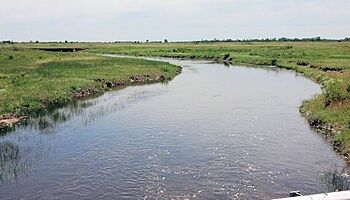Rattlesnake Creek (Kansas) facts for kids
Quick facts for kids Rattlesnake Creek |
|
|---|---|

Rattlesnake Creek near Zenith, Kansas
|
|
| Other name(s) | Salt Creek |
| Country | United States |
| State | Kansas |
| Region | High Plains |
| Physical characteristics | |
| Main source | Near Kiowa, High Plains, Kansas, United States 1,729 ft (527 m) 37°28′30″N 099°46′35″W / 37.47500°N 99.77639°W |
| River mouth | Arkansas River Near Sterling, Kansas, United States 527 ft (161 m) 38°12′59″N 098°30′00″W / 38.21639°N 98.50000°W |
| Length | 95 mi (153 km), Northeast-Southwest |
| Basin features | |
| River system | Arkansas River watershed |
Rattlesnake Creek is a stream about 95 miles (153 km) long in central Kansas. It flows into the Arkansas River. This creek is an important part of the local environment.
Contents
Discovering Rattlesnake Creek
Rattlesnake Creek is a long stream that winds through several counties in Kansas. It's a key part of the water system in this area.
Its Journey Through Kansas
Rattlesnake Creek starts in northern Kiowa County. From there, it flows towards the northeast. It travels through Edwards County and Stafford County. Finally, it joins the Arkansas River in Rice County.
A Home for Wildlife
As it flows, Rattlesnake Creek goes right through the Quivira National Wildlife Refuge. This refuge is a special place for many animals. The creek actually divides the refuge into two parts. It provides water and habitat for birds, fish, and other wildlife living there.
The Name of the Creek
For a long time, this stream had a few different names. People called it Rattlesnake Creek, Salt Creek, or even West Fork Rattlesnake Creek. In 1971, the Department of Interior officially decided on one name. Since then, it has been known as Rattlesnake Creek.

